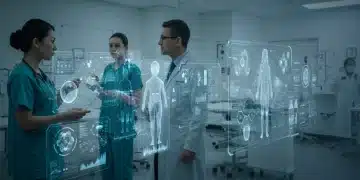The Rise of Bio-Integrated Tech: 4 Key Developments by Mid-2025

Bio-integrated tech is poised for significant advancements by mid-2025, with four key developments expected to redefine healthcare, human-machine interaction, and environmental sustainability through innovative biological and technological convergence.
The convergence of biology and technology is accelerating at an unprecedented pace. The Rise of Bio-Integrated Tech: 4 Key Developments Expected by Mid-2025 promises to reshape industries from healthcare to environmental sustainability, impacting our daily lives in profound ways. What are these groundbreaking advancements, and how will they change our future?
Revolutionizing Medical Diagnostics and Therapeutics
By mid-2025, bio-integrated technologies are expected to profoundly transform medical diagnostics and therapeutics. These advancements are moving beyond traditional methods, offering more precise, personalized, and proactive healthcare solutions. The integration of biological systems with advanced electronics is leading to devices capable of real-time monitoring and targeted treatment delivery, changing how diseases are detected and managed.
One primary area of focus is the development of next-generation implantable sensors. These devices are designed to continuously monitor physiological parameters with unprecedented accuracy. They can detect subtle changes in biomarkers, providing early warnings for conditions like heart disease or diabetes, long before symptoms manifest. This proactive approach holds the potential to significantly improve patient outcomes and reduce healthcare costs.
Advanced Biosensors for Early Detection
New biosensors are emerging that can be seamlessly integrated into the body, offering continuous data streams. These sensors are not just measuring basic vital signs but are sophisticated enough to detect specific molecules and cellular activities indicative of health or disease.
- Continuous Glucose Monitoring (CGM): Enhanced CGM systems are becoming less invasive and more accurate, providing real-time data for better diabetes management.
- On-Body Chemical Analysis: Wearable patches and minimally invasive implants are detecting metabolic changes, stress markers, and even early signs of infection from sweat or interstitial fluid.
- Targeted Drug Delivery Systems: Bio-integrated devices are being developed to release drugs precisely where and when needed, minimizing side effects and maximizing therapeutic efficacy.
Breakthroughs in Neural Interface Technologies
Neural interface technologies, often referred to as brain-computer interfaces (BCIs), are rapidly advancing, promising to bridge the gap between human thought and digital command. By mid-2025, we anticipate significant breakthroughs that will enhance human capabilities and restore lost functions. These technologies are moving from experimental labs into more practical applications, offering new hope for individuals with neurological disorders and opening doors for novel human-machine interactions.
The progress in miniaturization and improved signal processing is making these interfaces more efficient and less invasive. Researchers are focusing on developing devices that can interpret neural signals with greater precision, allowing for more intuitive control of external devices or even direct communication with digital systems. This represents a monumental leap in how humans interact with their environment and technology.
Enhanced Prosthetics and Exoskeletons
One of the most immediate and impactful applications of advanced neural interfaces is in the control of prosthetics and exoskeletons. These devices are becoming extensions of the user’s own body, responding to neural commands with fluidity and precision.
- Intuitive Prosthetic Control: Users are gaining more natural control over advanced prosthetic limbs, allowing for complex movements and sensory feedback.
- Neural-Controlled Exoskeletons: For individuals with severe mobility impairments, exoskeletons are being developed that respond directly to brain signals, enabling walking and other movements.
- Restoration of Sensory Function: Beyond motor control, research is progressing on interfaces that can restore or enhance sensory perceptions, such as touch or sight, through neural stimulation.
Sustainable Bio-Manufacturing and Materials
The push for sustainability is driving innovation in bio-integrated tech, leading to significant developments in bio-manufacturing and the creation of novel bio-materials. By mid-2025, expect to see a greater adoption of biologically inspired and produced materials that are environmentally friendly, biodegradable, and often superior in performance to traditional synthetic alternatives. This shift is crucial for reducing our ecological footprint and fostering a circular economy.
Companies and research institutions are leveraging biological processes to create materials and products with minimal environmental impact. This includes everything from bio-plastics derived from renewable resources to self-healing materials that mimic natural biological repair mechanisms. The integration of biological principles into manufacturing processes is not just about being green; it’s about creating more efficient, adaptable, and resource-effective solutions.
Bio-Inspired Self-Healing Materials
Materials that can repair themselves automatically, drawing inspiration from biological systems, are moving closer to commercial viability. These materials significantly extend product lifespans and reduce waste.
- Polymer Composites: Self-healing polymers are being developed for applications in aerospace, automotive, and consumer electronics, reducing maintenance needs and improving safety.
- Bioconcrete: Concrete embedded with bacteria that can produce calcium carbonate to fill cracks, enhancing structural integrity and longevity.
- Adaptive Coatings: Coatings that can autonomously respond to environmental damage, such as corrosion or scratches, protecting underlying surfaces.
Advanced Bio-Electronic Interfaces for Human Augmentation
The field of human augmentation is witnessing rapid advancements through sophisticated bio-electronic interfaces. By mid-2025, these technologies are expected to move beyond medical applications, offering enhancements to human cognitive and physical capabilities. These developments are not just about fixing what’s broken but about expanding what’s possible, blurring the lines between human and machine in novel ways. The ethical implications and societal impacts of these advancements are also increasingly a topic of discussion.
The focus is on creating seamless, intuitive interfaces that can either feed information directly into the brain or allow for more sophisticated control of external devices. This includes improvements in sensory perception, memory, and even communication, pushing the boundaries of what it means to be human. The goal is to create a symbiotic relationship between biological and electronic systems, enhancing our natural abilities.

Cognitive Enhancement via Direct Neural Stimulation
Research into direct neural stimulation is progressing, with the potential to enhance cognitive functions such as memory, learning, and attention. These non-invasive or minimally invasive techniques aim to modulate brain activity for improved performance.
- Transcranial Magnetic Stimulation (TMS): Advanced TMS devices are being explored for their potential to improve focus and accelerate learning processes.
- Targeted Electrical Stimulation: Precise electrical pulses are being used to stimulate specific brain regions, potentially boosting memory recall and problem-solving skills.
- Biofeedback Systems: Integrated biofeedback loops are allowing individuals to gain better control over their own brainwaves and physiological states for enhanced cognitive performance.
Ethical Considerations and Societal Impact
As bio-integrated tech advances, so do the ethical considerations and potential societal impacts. The rapid pace of innovation necessitates a proactive approach to addressing concerns regarding privacy, equity, and the very definition of human identity. By mid-2025, these discussions are expected to intensify, shaping regulatory frameworks and public perception.
The ability to augment human capabilities, monitor health in real-time, and create biologically derived materials raises profound questions. Who has access to these technologies? How will they affect social stratification? What are the long-term consequences of integrating technology so deeply with our biology? These are not hypothetical questions but pressing issues that require immediate attention from policymakers, ethicists, and the public alike.
Navigating the Future of Human-Tech Integration
Addressing the ethical landscape requires a multi-faceted approach, balancing innovation with responsibility. Open dialogue and robust regulatory frameworks are essential to ensure these technologies benefit all of humanity.
- Data Privacy and Security: Ensuring the protection of highly sensitive biological and neural data is paramount as bio-integrated devices become more common.
- Equitable Access: Preventing a ‘bio-divide’ where only a select few can afford or access advanced augmentations and medical treatments.
- Defining Human Identity: Grappling with philosophical questions about what it means to be human in an era of advanced biological and technological integration.
Investment and Innovation Landscape
The investment landscape for bio-integrated tech is booming, with venture capital and government funding pouring into promising startups and research initiatives. By mid-2025, this sector is expected to see continued rapid growth, driven by both technological feasibility and market demand. Major players in tech, healthcare, and materials science are actively acquiring and partnering with bio-integrated tech firms, signaling a strong belief in its future potential.
Innovation is not confined to traditional biotech hubs; a global network of researchers and entrepreneurs is contributing to this field. The interdisciplinary nature of bio-integrated tech, combining biology, engineering, computer science, and material science, fosters a dynamic environment for breakthrough discoveries. This collaborative ecosystem is accelerating the translation of laboratory research into real-world applications, making the projected developments by mid-2025 increasingly tangible.
Key Investment Areas and Growth Drivers
Strategic investments are focusing on areas with high potential for both medical and commercial applications, indicating a broad impact across various sectors.
- Neurotechnology Startups: Significant funding is directed towards companies developing advanced BCIs and neural prosthetics.
- Bio-manufacturing Facilities: Investments are flowing into infrastructure for scalable and sustainable production of bio-materials and bio-fabricated products.
- Personalized Medicine Platforms: Development of platforms that leverage bio-integrated sensors for highly personalized diagnostic and therapeutic solutions.
| Key Development | Brief Description |
|---|---|
| Medical Diagnostics & Therapeutics | Advanced implantable sensors and targeted drug delivery systems for personalized, proactive healthcare. |
| Neural Interface Technologies | Enhanced BCIs for intuitive control of prosthetics and exoskeletons, bridging thought and digital command. |
| Sustainable Bio-Manufacturing | Development of eco-friendly, self-healing bio-materials and biologically inspired manufacturing processes. |
| Human Augmentation | Bio-electronic interfaces enhancing cognitive and physical human capabilities beyond traditional limits. |
Frequently Asked Questions About Bio-Integrated Tech
Bio-integrated tech refers to the convergence of biological systems with advanced technological components, such as electronics or materials science. It aims to create devices and systems that interact seamlessly with living organisms, often for medical, environmental, or human augmentation purposes.
By mid-2025, bio-integrated tech is expected to revolutionize healthcare through advanced implantable sensors for early disease detection, personalized diagnostics, and highly targeted drug delivery systems. This will lead to more proactive and effective patient care.
Safety is a paramount concern for neural interfaces. Researchers are continuously working to minimize invasiveness and ensure biocompatibility. While still in early stages for widespread use, ongoing clinical trials are rigorously evaluating their safety and efficacy for specific medical applications under strict protocols.
Self-healing bio-materials are engineered substances that can autonomously repair damage, mimicking biological processes. Examples include polymers and concrete with embedded healing agents. These materials extend product lifespans, reduce waste, and improve the sustainability of various industries.
Key ethical challenges include data privacy for sensitive biological information, ensuring equitable access to advanced technologies, and addressing questions about human identity and augmentation. These issues require careful consideration and robust regulatory frameworks as the field progresses.
Looking Ahead
The trajectory of bio-integrated technology indicates a future where the lines between biology and engineering continue to blur. The developments expected by mid-2025 are not isolated advancements but interconnected pieces of a larger puzzle, pointing towards a new era of human interaction with technology and the environment. Stakeholders must remain vigilant, collaborating across disciplines to navigate the ethical landscape and ensure these powerful tools are wielded responsibly for the benefit of all. The coming months will be critical in shaping the adoption and impact of these transformative innovations.





